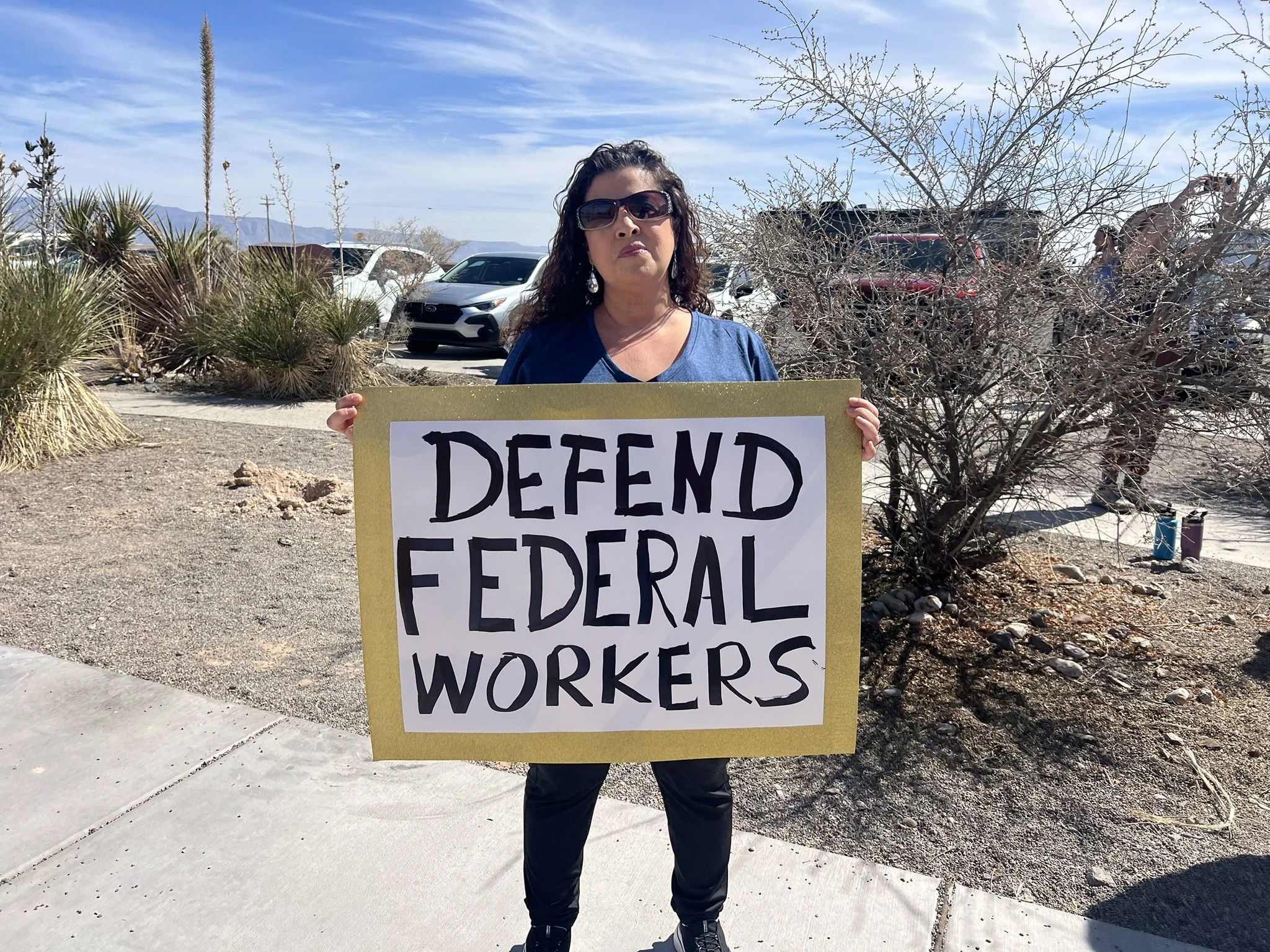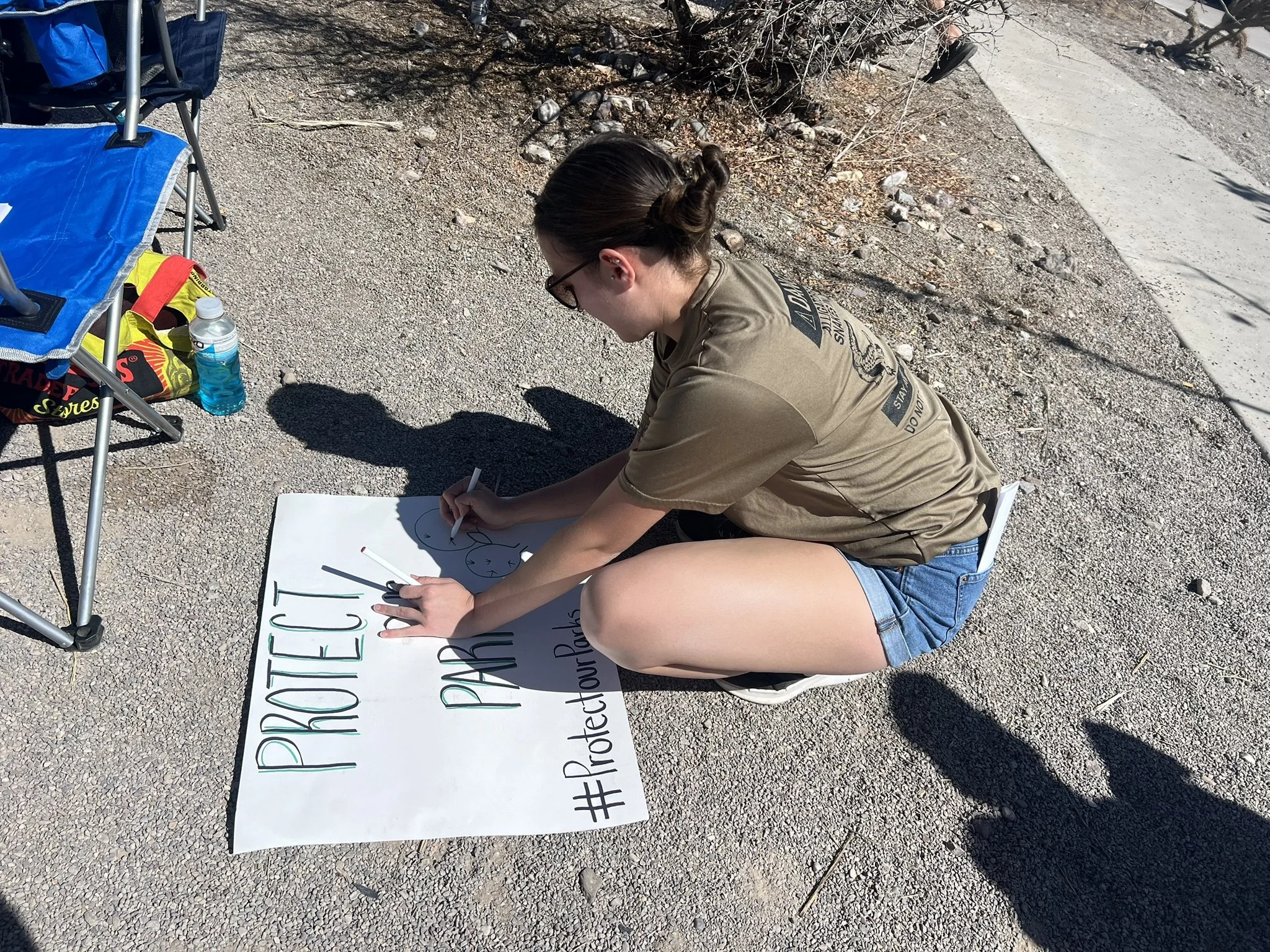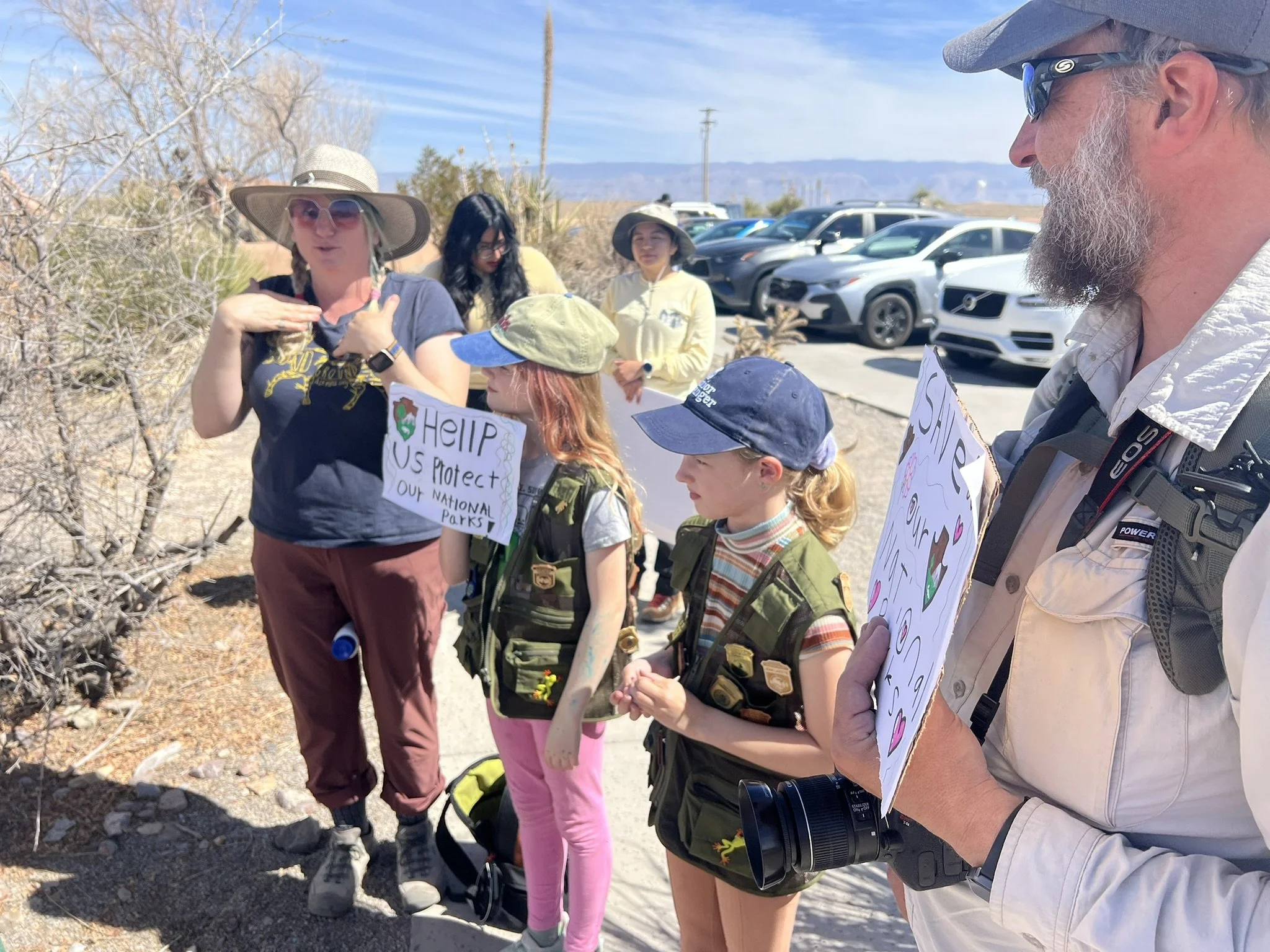DOGE-led firings stir unease across Southern New Mexico
Bella Johnson, New Mexico State University student, joins a March 1, 2025, demonstration at White Sands National Park to urge people to: “Protect our parks.” (Photo by Elva K. Österreich/ SNMJC)
From national parks to the VA, residents count the costs
By Elva K. Österreich & Diana Alba Soular
Southern New Mexico Journalism Collaborative
SOUTHERN NEW MEXICO – Across Southern New Mexico and the country individuals were terminated from their federal jobs in recent weeks by the Elon Musk-run Department of Government Efficiency as part of a massive, controversial effort to save money.
Many are questioning if those job cuts are actually good for a region with millions of acres of public lands and several federal facilities and parks that contribute significantly to local economies.
The DOGE website claims it has saved an estimated $115 billion through cost-savings measures, including workforce reductions, but the site’s list of savings has proven to be flawed.
In addition to the loss of jobs, consequences of the firings across Southern New Mexico could include increased fire danger during upcoming fire seasons in the state’s national forests, potential impacts to tourism and local economies due to curtailed operations, fewer opportunities for colleges students currently enrolled in programs geared to those jobs that are being reduced, and cuts to veterans services.
Recent developments – namely two judges ordering the Trump Administration on Thursday, March 13 to reinstate fired probationary employees across multiple agencies, at least in the short-term – leave many workers in limbo.
Thursday also was the deadline for agencies to submit plans for more cuts. And while several plans have come to light, details of possible other reductions in workforce remain unknown.
Congressman: Information lacking
U.S. Rep. Gabe Vasquez, a Democrat whose district covers much of Southern New Mexico, said his office has heard from thousands of constituents over the past few weeks about federal firings.
“We have lost key staff at places like the Gila National Forest and Carlsbad Caverns, and we are still looking to get more information,” Vasquez said, prior to Thursday’s order. “Part of the trouble right now is just getting accurate information. I think federal employees are scared to speak up and speak out about what’s happening to them in fear of retribution from this administration so we are not getting a clear picture of the numbers of the folks that have been fired.”
The cuts – a combination of firings of probationary employees and forced resignations or early retirements – have been fast-paced and chaotic. And exact numbers of job losses across New Mexico have been difficult to pin down, even for U.S. lawmakers. That’s in part because the Trump Administration’s process has lacked transparency; agency spokespersons’ jobs appear to have been terminated in some cases or they’re hesitant to speak on the cuts; and current and fired employees worry about retaliation for giving out information.
Denise Ottaviano of Tularosa, New Mexico, displays her sign as she demonstrates during an event March 1, 2025, at White Sands National Park in support of federal workers. (Photo by Elva K. Österreich/ SNMJC)
How big is NM’s federal workforce?
Statewide, as many as 44,000 workers were employed by the federal government, representing about 1 out of every 20 jobs, according to the nonpartisan Economic Policy Institute. Among states and the nation’s capital, New Mexico has the fourth-highest percentage of federal workers making up its workforce. About one-quarter of those jobs are tied to counties in Southern New Mexico, according to the institute’s numbers.
Vasquez said more than 20% of Carlsbad Caverns National Park site employees were let go as of the week ending March 7. Local and national media have reported 14 out of 25 seasonal interpreter rangers were terminated at the park, leading to the abrupt cancellation of guided cavern tours and some curtailment of self-guided tours.
Vasquez said, should the cuts stand, they will hinder the park’s ability to serve New Mexicans and other visitors alike.
“What we are hearing from our folks is that all those operations will be impacted,” Vasquez said.
“Using Carlsbad Caverns as an example, they let us know that they were canceling their after-school programs and significantly reducing their visitor center hours.”
A day after the federal judges’ orders to reinstate probationary employees, the park’s website still stated that guided tours are curtailed.
Carlsbad Caverns, a UNESCO World Heritage site that’s among New Mexico’s most popular attractions, draws some 400,000 visitors annually with an estimated local economic impact of nearly $32 million. Statewide, outdoor recreation accounted for about $3.2 billion in economic value in 2023, nearly 2.5% of the state’s GDP.
Vasquez said if there are fewer staffers working at federal sites, adventurers can expect their recreation experience to suffer with less attention given to things like toilets, trash cans, and visitor centers. There could be fewer rangers to help in a time of need.
Student: ‘We are scared about the loss of funding’
Other federally managed attractions across Southern New Mexico include Organ Mountains-Desert Peaks National Monument near Las Cruces, White Sands National Park near Alamogordo, and the Gila Cliff Dwellings National Monument north of Silver City, and the Bosque del Apache National Wildlife Refuge near Socorro. The Southern New Mexico Journalism Collaborative was not able to verify if staff were fired from those recreation sites, or, if so, how many jobs were affected.
The U.S. Bureau of Land Management under the Department of Interior manages about 13.5 million acres across New Mexico for grazing, recreation and oil and gas production. A person familiar with the Las Cruces office told SNMJC there haven’t been cuts to its staffing, at least not yet.
On Saturday, March 1, a demonstration in support of federal workers was held at national parks across the country. At White Sands National Park, more than 30 people gathered with signs and chants. Many of those at the site were students in wildlife and range science studies from area colleges.
Samantha Aguilar, a New Mexico State University student studying wildlife science, said they are worried about their futures.
“It really matters to us,” she said. “We are scared about the loss of funding for our national parks, and a lot of us rely on federal jobs when we leave school. Those are the jobs that provide us with stability and good benefits. A lot of people that I know personally have lost their jobs, and it’s terrifying for us to think that there may not be places for us when we graduate.”
New Mexico State University wildlife science student Samantha Aguilar creates a sign during the March 1, 2025, demonstration at White Sands National Park. (Photo by Elva K. Österreich/ SNMJC)
Forest Service jobs cut, reinstated
The USDA is a key agency managing swaths of forests across Southern New Mexico, including the 3.3-million-acre Gila National Forest and the 1.6-million-acre Cibola National Forest in the southwest, and the 1.1-million-acre Lincoln National Forest in the south-central and southeast.
At least 13 trails and recreation crew at the Gila National Forest had their jobs cut in mid-February, the Silver City Daily Press reported.
The Sacramento Ranger District of the USDA’s Forest Service saw at least 11 personnel terminated, according to the Cloudcroft Reader news site.
However, an independent federal board later issued a 45-day hold on the firings, leading to a reinstatement of some 6,000 probationary USDA employees, including Forest Service personnel. Their future, however, remains uncertain.
Vasquez said federal land management agencies are already shorthanded.
“The process to hire staff at places like the U.S. Forest Service is already cumbersome enough,” he said. “Sometimes it takes six months to a year just to hire one employee. Sometimes this is in remote places like Grant County or Catron County.”
Because there is already a depleted workforce managing federal public lands, Vasquez said, further depletion of the workforce is going to greatly impact the ability to manage fire-sheds as we head into a fire season that looks to be pretty dry with a lot of fuels and high winds.
“Everybody has a role to play whether they are a soil scientist or a fire specialist,” he said. “All those positions are critical to mitigating the impact of wildfires in our state.”
Vasquez argued the cost of a wildfire alone easily outweighs the cost saved by firing federal employees who are making $40,000 to $50,000 a year. “Those costs to the taxpayer are going to be much greater.”
Jen Goepfert and Travis Pedersen have been traveling in an RV across the country from national park to national park while homeschooling their twin daughters, Aela and Eva, 9, using the park service’s Jr. Ranger program. They have been through 33 parks. The family joined the demonstration at White Sands earlier this month.
“These parks belong to us, so we are here to share our support for the employees,” Goepfert said. “We are really here to enjoy the national parks, we want to share them with our children.”
She said they have seen morale dip at the parks lately and considered going home because they don’t want to put the stress on the park service and infrastructure.
“Then we realized if we go home, if people stop going to parks, they will be more encouraged to cut funding,” she said. “So we want to encourage people to keep visiting parks – be good stewards, be polite to the remaining staff, share your support and love with everyone out there.”
Veterans worry about cuts
Vasquez said many of the contacts his office has gotten have been from veterans, as they see more employees being let go at both El Paso and Albuquerque Veterans Health Administration facilities. Veterans from across Southern New Mexico seek services in both cities. Many veterans are already waiting days and weeks to see doctors or specialists, and they are afraid the waits will get longer, he said.
“What we are worried about most are the VA staff cuts,” he said. “We just saw a report that was leaked that the administration planned to eliminate 80,000 jobs from the Veterans Administration which is an incredible number. This unpredictable environment makes it even more difficult to attract these full professionals to New Mexico and especially to our rural communities.”
Indeed, the Department of Veterans Affairs is planning a reorganization that would cut 80,000 jobs from the agency, according to the Associated Press. It's not clear yet how many jobs will be cut in New Mexico or in out-of-state cities serving New Mexicans. At least one fired VA employee in the state shared her story with KRQE News.
Vasquez’s office is working to help find solutions for a Center for Disease Control employee who has been working remotely out of her home in Otero County. The employee, who works in a critical research capacity, received notice that unless she had an office location within a week she would be fired through the return to work in-person executive order.
The federal judges’ orders of last week are a short-term reprieve for federal employees. It’s unclear how long a final resolution of the pertinent court cases could take.
Waste Isolation Pilot Plant reversal
Vasquez on Monday, March 10 touted the reversal of a potential, DOGE-directed lease termination for a key building connected to the Waste Isolation Pilot Plant (WIPP) south of Carlsbad. He’s argued against lay-offs at WIPP, too.
“That is a nuclear waste depository, for defense-related nuclear waste, and it’s the only one of this type in the country,” he said.
Jen Goepfert, left, and Travis Pedersen, right, travel across the country visiting national parks in their RV homeschooling their children, Aela and Eva, both 9, center. They stopped March 1, 2025, at White Sands National Park in Southern New Mexico to join in a demonstration supporting federal workers before they went to explore the park. (Photo by Elva K. Österreich/ SNMJC)
Elva K. Österreich is a freelance journalist based in Las Cruces and Alamogordo. Diana Alba-Soular is the project editor for the Southern New Mexico Journalism Collaborative, a partnership of newsrooms in Southern New Mexico. For more info, visit www.southNMnews.org.





